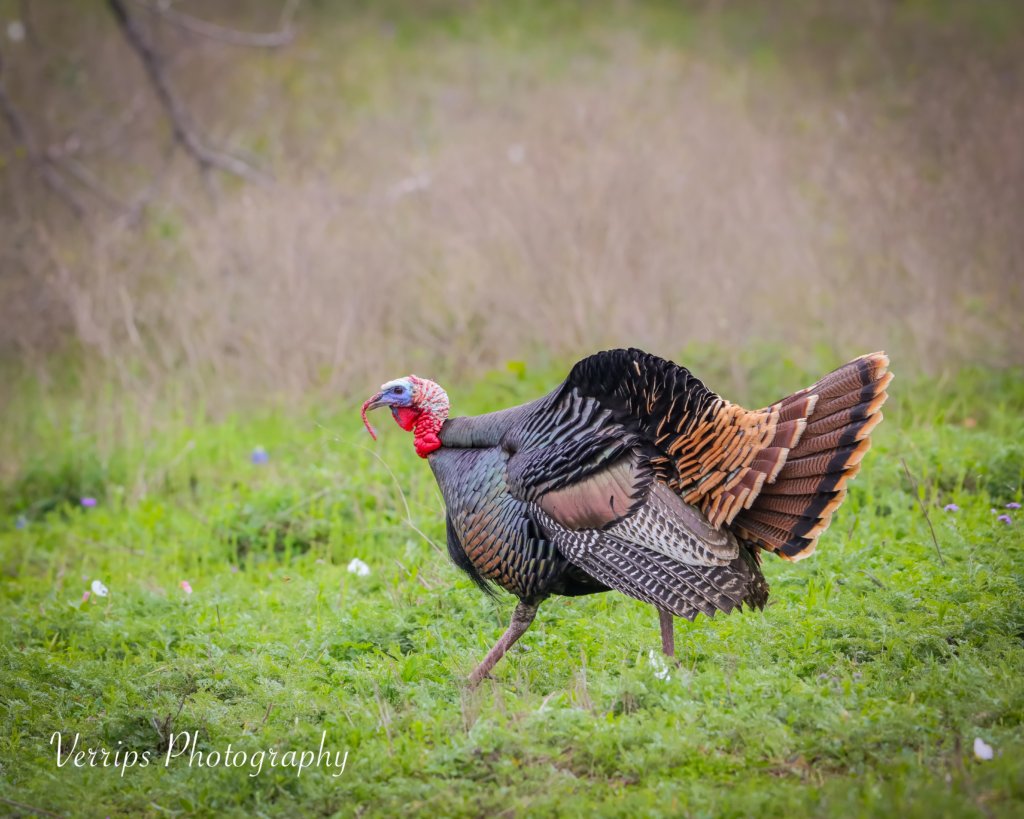
Gobbler chasing hens on a spring evening - Photo by Dan Verrips
Texas Wildlife Exemption: The Other “Exemption”
In Texas, fragmentation is often recognized as the division of rural land into smaller pieces to accompany commercial or residential development. Large pieces of rural land, once teeming with wildlife, flowing with wild creeks, and overgrown with lush, native vegetation are being lost to fragmentation at an alarming rate.
Where it began:
In 1995, Texas voters approved Proposition 11, which amended Article VIII, Section 1-d-1 of the Texas Constitution to permit agricultural appraisal for land used to manage wildlife. H.B. 1358 implemented the constitutional amendment by making wildlife management an agricultural use that qualifies the land for agricultural appraisal. The purpose of the bill was not to “save wildlife,” but “…to preserve open space land…” Traditional agricultural operators had no recourse to keep their property taxes at a reasonable rate if they ceased their agricultural operations, and largely could not afford their property taxes if they increased to fair market levels.
How it works:
The difference between a fair market valuation and the 4 special use valuations (Agriculture, Wildlife, Timber, and Ecological Laboratory) is not the tax rate, but the way land is valued. In a fair market valuation, which is reserved mainly for non-revenue-producing commercial and residential properties, the property taxes are based on the value at which the property should sell in a fair market scenario. Most of these values end up being lower than the actual sale price a realtor would recommend, but they are usually within 20%. The tax rate, usually in the 1.5-2.5% range, is then multiplied by that value to determine the property tax amount. So, a $500,000 home on a $100,000 lot in an area where the property tax rate, which is determined by city services, school districts, and other criteria, is 1.75% would receive an annual property tax bill of $10,500 or ($600,000 * .0175).
In a rural property scenario, the fair market values are probably cheaper, but the typical landowner owns many, many times more land than the typical residential landowner. That means if the property taxes on a $3,000,000 Hill country farm were the same, the taxes could be upwards of $50,000 per year. That, coupled with the steep cost of ownership that comes with rural land, is too much for most landowners to afford long-term. Thus, the 1-d-1 Open Space Agricultural Valuation was passed back in the 1960’s, and it allows rural land to be valued on the productivity of the land instead of the fair market value. Now the question is not how much the land will sell for in an open market scenario, but how much revenue it can realistically produce. So, if our $3,000,000 farm can realistically produce $250,000 in revenue selling Crop A, the property taxes are ($250,000 * .0175) or $4,375, a near 95% reduction! This makes the farm more affordable for the landowner, and he or she is able to keep producing that valuable commodity, and the land stays intact.
Fast-forward 30-some-odd years and normal agricultural operations are sadly not as profitable. Land is being passed down to a generation of people who will not carve their livelihoods from the loamy soils, but will instead vacation there, raise their children with an appreciation for open spaces, and make that land a central part of their legacies. The same way the farmer in our previous example could not afford to quit agriculture, this new generation of landowner could not afford to give up their hay or cattle lease, or, in some cases, could not even afford to inherit the property in the first place. H.B. 1358 and the Wildlife Tax Valuation changed it all.
The Texas Parks & Wildlife Department, which was responsible for setting up the guidelines surrounding this controversial law, defined wildlife management as, “Actively managing land to propagate a sustaining breeding, migrating, or wintering population of indigenous wild animals for human use, including food, medicine, or recreation.” Wow! What a broadly-written and landowner-friendly law. That means all a landowner needs to do is choose a target species, and manage for it.
Managing for the “Exemption”
So what does “manage for it” mean?
TPWD outlined 7 categories of wildlife management to choose from. A landowner must implement 3 of the 7 categories each year to qualify for the valuation although in many cases 4-5 are chosen. The categories are:
- Supplemental Food
- Supplemental Water
- Supplemental Shelter
- Habitat Control
- Erosion Control
- Predator Control
- Census
Within each of these categories, there are many different activities. For instance, Supplemental Shelter for songbirds can be implemented as nest boxes (“bird houses”), brush piles, or even strip mowing; Predator Control can mean poisoning imported red fire ants or hunting feral hogs; Supplemental Water can mean everything from modifying an existing livestock trough to installing an elaborate rainwater collection system.
To qualify for a 1-d-1w, or Wildlife Valuation, a landowner should submit a wildlife management plan form and application to their Central Appraisal District. The Appraisal District is responsible for administering and monitoring property tax valuations (these are not “exemptions”, the landowner MUST pay property taxes!), using Form PWD-885. The plan shall be approved *by law* if the land has been previously appraised in an Agricultural Valuation and has not been reduced in size (to a certain, geographically-set threshold) the previous year.
That is it. There are no hoops to jump through, and very little red tape. The law is written for landowners, and more than 17 years after it was written, over 30 million acres of Texas land is under 1-d-1w. If you’re a landowner who does not want to produce livestock, crops, forage OR pay exorbitant property taxes, it could be your perfect property tax solution. For more information on what it takes to qualify and how to convert your property to a wildlife valuation, call your local tax assessor today!
This article was written By Craig Bowen.
For more information about the Wildlife Tax “Exemption” feel free to check out the following links:
